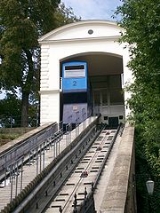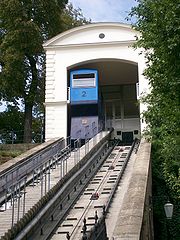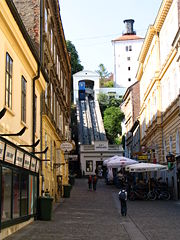
Zagreb Funicular
Encyclopedia


Funicular
A funicular, also known as an inclined plane or cliff railway, is a cable railway in which a cable attached to a pair of tram-like vehicles on rails moves them up and down a steep slope; the ascending and descending vehicles counterbalance each other.-Operation:The basic principle of funicular...
in Zagreb
Zagreb
Zagreb is the capital and the largest city of the Republic of Croatia. It is in the northwest of the country, along the Sava river, at the southern slopes of the Medvednica mountain. Zagreb lies at an elevation of approximately above sea level. According to the last official census, Zagreb's city...
operated by ZET
ZET
The Zagrebački električni tramvaj is the major transit authority responsible for public transport in Zagreb, the capital of Croatia, and one part of the Zagreb County. ZET is now a branch of the Zagreb Holding...
, situated in Tomić Street, connecting the Ilica Street (Donji Grad
Donji Grad
Donji grad is one of the 17 city districts of Zagreb, the capital of Croatia. It is located in the central part of the city and has 45,108 inhabitants . The official name of the district is rarely used, for it is dubbed centar by most of the Zagreb residents....
) with Strossmayerovo šetalište (Strossmayer promenade) to the north (Gornji Grad
Gradec, Zagreb
Gradec or Grič is a part of the Zagreb, Croatia, and together with Kaptol it is the mediaeval nucleus of the city. It's situated on the hill of Gornji Grad.- History :Gradec was given a royal charter by King Bela IV in 1242...
).
Its 66 metres (216.5 ft) track makes it one of the shortest public-transport funiculars in the world. The funicular was built in 1890 and has been in operation since April 23, 1893. Initially it had steam engines, which were substituted with electrical in 1934. Having in mind that it kept its original shape, constructional and most of the technical properties, it was given legal protection as a monument of culture.
Technical characteristics
It has two cars for 28 passengers each (16 seated and 12 standing places). The cars are 5640 mm long, and weigh 5,05 tons when empty. Each can carry 2240 kg. The electrical engine is in the northern (upper) station. It has a power output of 28.5 kW, operates on 400 V direct currentDirect current
Direct current is the unidirectional flow of electric charge. Direct current is produced by such sources as batteries, thermocouples, solar cells, and commutator-type electric machines of the dynamo type. Direct current may flow in a conductor such as a wire, but can also flow through...
, at 720 revolutions per minute
Revolutions per minute
Revolutions per minute is a measure of the frequency of a rotation. It annotates the number of full rotations completed in one minute around a fixed axis...
. The funicular runs on 1200 mm gauge rails, track length is only 66 m, but height difference is 30.5 m and inclination 52%. This makes it one of the shortest, but also one of the steepest funiculars in the world. It runs at a speed of 1.5 m/s, needing 55 seconds to cross the distance.

